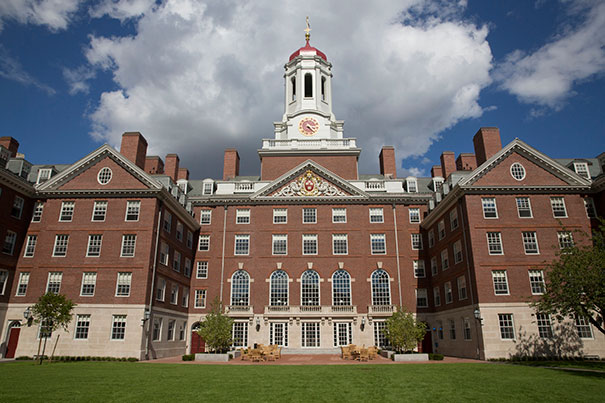
For 15 months workers carefully renewed Dunster House, including its tower, which can be seen from the front courtyard (photo 1). On Saturday, during move-in day, Tim Kang ’18 (left, photo 2) and roommate Griffin Gonzales ’18 admired their transformed House. “They set up a lot of places for people to get together — benches where someone can join you to sit,” said Kang. The library’s carved fireplace mantels were also restored, making them look much like they did when the House opened in 1930 (photo 3).
Photos (1, 3) by Kris Snibbe, (2) by Jon Chase/Harvard Staff Photographers
No loss of character in new-look Dunster
House reopens after 15-month renewal project
It’s the smell of polished wood, deep and warm, that hits you first when you enter the renewed Dunster House. And for good reason, because throughout the House ― from new common rooms lined with windows, to high-tech smart classrooms and new basement exercise spaces ― walls are covered in polished wood. The deep-brown panels were once wainscoting in the Dunster student rooms, now repurposed, and like the House itself, renewed.
In the dining room and the library, carved-wood fireplace mantels and walls have been carefully restored, each leaf and scroll burnished to original glory, making them look much like they did when the House opened in 1930. But look closely, and you’ll see that the nicks and lines from use by generations of students reveal the age of the old wood. Look closer still, and you’ll notice the original wood window frames now wrap around energy-efficient panes.
Modern twist on Harvard classic
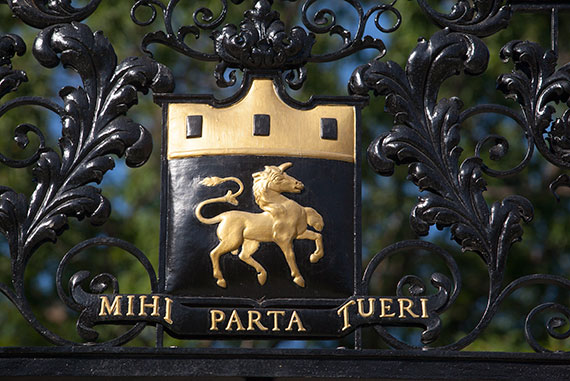
A detail from the gate at the newly renovated Dunster House. Photos by Jon Chase/Harvard Staff Photographer
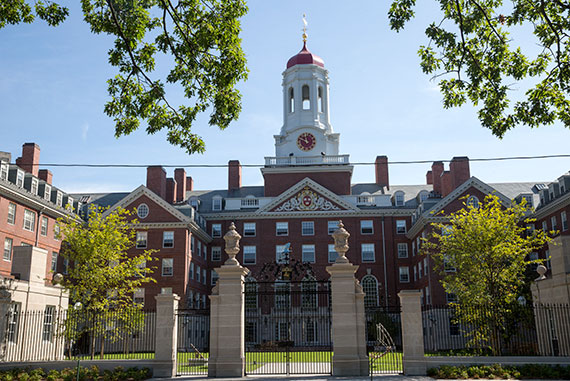
It took more than a year for 400 workers to renew Dunster’s 183,060 square feet: 57 chimneys, 56 suites with common rooms, 10 common rooms on the residential floors, and 863 windows.
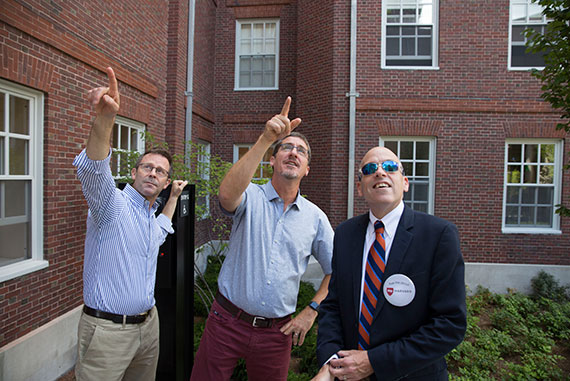
A tour of the newly renovated Dunster House was conducted on Friday with Dean of Student Life Stephen Lassonde (from left), Administrative Dean for Science Russ Porter, and Michael Patrick Burke, registrar of the Faculty of Arts and Sciences. Kris Snibbe/Harvard Staff Photographer
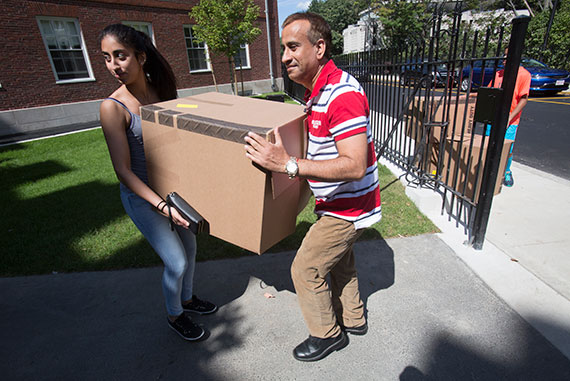
Saturday’s move-in day at Dunster had Shivangi Parmar ’17 (left) getting a helping hand from her father, Kulbir Parmar.

The majestic dining hall was part of the pre-student tour. Russ Porter (left), administrative dean for science, was shown around by Merle Bicknell, assistant dean for FAS physical resources. Kris Snibbe/Harvard Staff Photographer
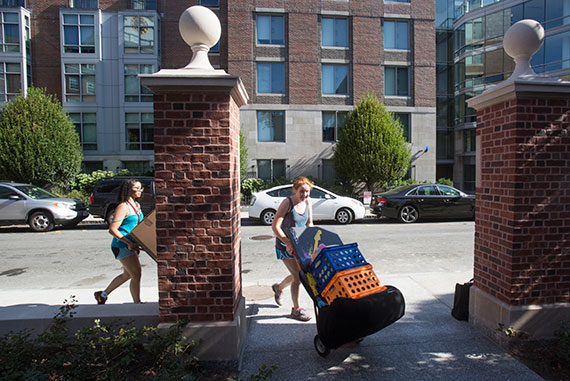
Zoe Onion ’18 (right) and Rachel Gilchrist ’18 take advantage of the beautiful day for moving crates.

One of the spacious common rooms that students have already praised for offering them a place to gather.
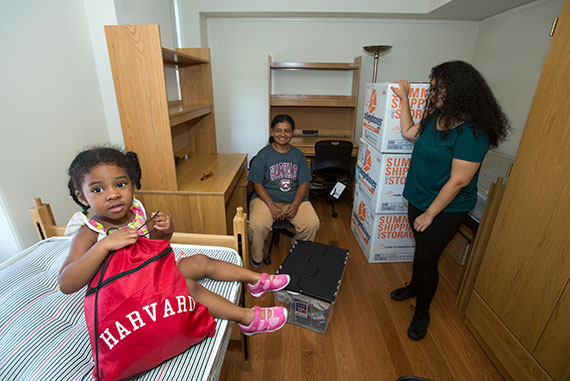
Jasmine McEacheron, 3, tries out a bed in the room of her aunt, Charity Barros ’18 (right), as Charity’s mother, Eucharis, shares in the moment.
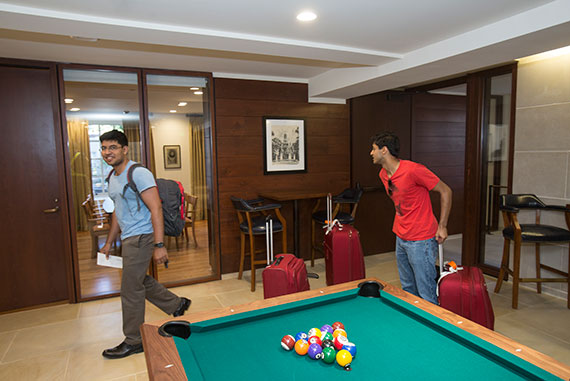
A pool table marks one of the lounge areas that Idrees Kahlon ’16 (left) and Vivek Banerjee ’16 pass through on the way to their room.

Colorful kettlebells, weights, and cardio machines fill the exercise room.
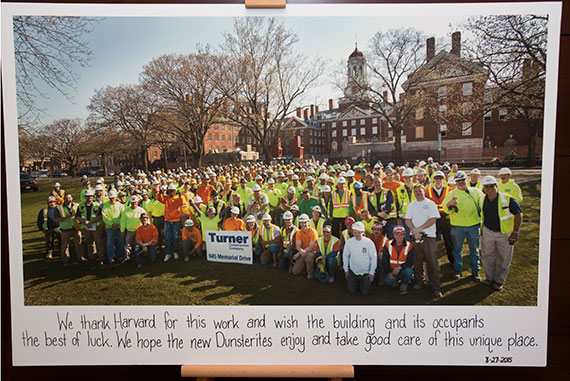
The construction crew presented Dunster House with a photo that included the inscription: “We thank Harvard for this work and wish the building and its occupants the best of luck. We hope the new Dunsterites enjoy and take good care of this unique place.”

The Dunster House shield remains a part of the household.
It is in the wood where you see the success of the project: respect for the history of cherished spaces, but also recognition of the advantages offered by modern technology, the needs of today’s students, and the importance of Harvard’s commitment to the transformative power of an undergraduate’s residential experience.
“Dunster House marks an important milestone in House renewal and serves as a powerful illustration of what we can and must accomplish to meet the needs of today’s students and the challenges of these times,” said Michael D. Smith, Edgerley Family Dean of the Faculty of Arts and Sciences. “Residential life at Harvard College is central to our students’ liberal arts and sciences education.”
Dunster House is the first House to be completely renewed, informed by test projects that transformed Stone Hall at Quincy House and McKinlock Hall at Leverett House. At Dunster House, for 15 months and through Boston’s snowiest winter on record, 400 workers — carpenters, electricians, painters, and more ― carefully renewed Dunster’s 183,060 square feet: 57 chimneys, 56 suites with common rooms, 10 common rooms on the residential floors, and 863 windows. Also part of the project: new bathrooms, new exercise space, smart-technology rooms, a new student grill, new kitchen space, and new spaces for study and learning for the 327 students who make Dunster House their home at Harvard.
“Dunster House is three times the size of the Stone Hall renewal,” said Merle Bicknell, assistant dean for FAS physical resources. “It provided important opportunities to apply new technologies and new approaches to save energy, restore historic spaces, and improve the quality of life and learning in the House. It will significantly and importantly inform our work going forward. ”
Sustainability is key to House renewal. Energy-efficient technology and resource conservation permeate the renewed building. During construction, the project team was able to recycle 96 percent of the existing materials (walls, flooring, and roof) throughout the historic structure. Sustainability features include a water-retention system and better-insulated walls and windows that have the dual benefit of reducing energy use and improving student comfort.
Dunster continues a tradition of excellence in sustainable restoration. In August of 2014, Stone Hall was certified Leadership in Energy and Environmental Design (LEED) platinum, the highest rating in the green-building certification program that recognizes best-in-class construction strategies and practices. The McKinlock Hall renewal is currently under review for certification.
“Old buildings like this don’t reveal their secrets easily, but we paid close attention and worked hard to protect the historic character of Dunster House and yet make sure it meets the needs of 21st-century students and the financial and environmental challenges of today and tomorrow,” said Steve Kieran of the architecture firm KieranTimberlake.
“Our involvement with the renovation and renewal of Dunster House has been an incredible construction experience,” said George Gaughan, vice president and construction executive for Turner Construction Co. “We look forward to the students moving in and have them see that Dunster has retained its historic features as many modern technological enhancements, student amenities, and sustainable building elements were added.”
Every floor of Dunster House was updated with new common study spaces, where students will find important technology upgrades. On the west side of the lower level, a high-tech “smart classroom” will give faculty the opportunity to teach classes in the building. Along the north corridor, an art studio and three soundproof music practice rooms were created. In what was previously a series of basement squash courts, Dunster House now offers a gym, including cardio equipment, free weights, a yoga studio, and a basketball court.
“It’s pretty cool to be a part of the first full renovation of a House in Harvard’s history,” said Kevin Chen ’17. “I’m grateful for the tremendous job that the project managers have done and look forward to seeing their upcoming makeover of Winthrop House.”
The renovated space also features a new, 80-person courtyard lounge that opens onto a spacious veranda — set against the backdrop of Dunster’s main lawn and the Charles River — that will serve as a site for student-faculty dinners and other functions to nurture community within the House.
From the riverside, on this day, the clock tower of Dunster House rises against a blue sky, a grand, beautiful trophy atop rows of windows and brick. Inspired by the famous Tom Tower of Christ Church in Oxford, England, the restored Dunster tower — once-crumbling wood, now replaced with a gold weathervane gleaming again — will be relit in a special ceremony for students on Sept. 1.
“The building looks incredible and everyone who worked on it did a phenomenal job,” said Ayo Opeyemi ’17. “It’s exciting to see all of Dunster trickle back in and fill the new building and I’m thrilled to be a part of it and I look forward to exploring the rest of the building.”
Dunster House Masters Roger and Ann Porter proudly opened their front doors to students and their families on Saturday morning.
“It is a joy to walk through the renewed Dunster House. It flows seamlessly from open common spaces through seminar rooms to the dining hall. Crowded spaces and restrictive stairways have given way to better access between floors, wider hallways, and beautiful suites and bedrooms,” said the Dunster House masters. “It is a wonderful combination of old and new. Dunster House has traditionally been a close-knit community, and the renewed space will help build on that tradition of inclusion, warmth, and camaraderie.”




